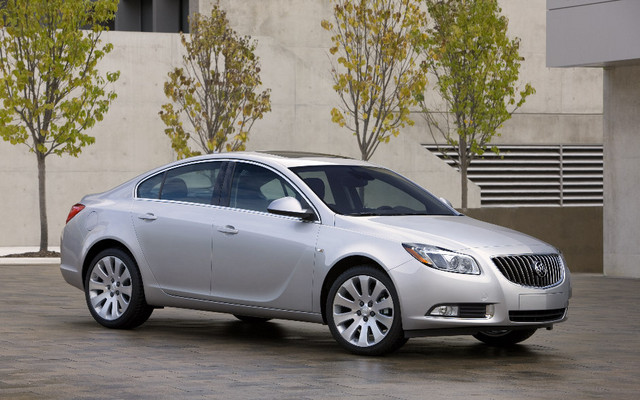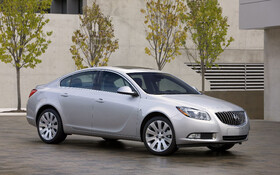2011 Buick Regal, great personality and road handling

| Strong points |
|
|---|---|
| Weak points |
|
When General Motors underwent restructuring last year, many believed that the Buick division would be sacrificed. Not only did it have few models to offer, but its sales were less-than-stellar compared to the Pontiac division. Indeed, people were surprised when Pontiac was laid to rest while Buick was given the chance to live on. Several factors played in Buick’s favour – most notably its popularity in China, which is not only one of the world’s biggest automobile markets right now, but it is expected to keep growing.
Once they had made this decision, GM went to work radically transforming the line of Buick products. Some three years back they had already made a first effort with the Enclave deluxe SUV. Then there was the LaCrosse, which launched last fall. Both vehicles were well received by critics and buyers alike.
Now it’s time for a smaller and more inexpensive model, the Regal. This was Buick’s mainstay for a long time before being abandoned. Today, it’s been brought back with a new silhouette and European platform. It also comes with a choice of two four-cylinder engines. That’s right – no V6 or V8 on the menu.
All prejudices aside
Not long ago, Buicks offered a very so-so styling. The manufacturer would have simply reused the same visual elements and that would have been that. This time, however, it’s the new GM and things have really changed. In fact, the Regal’s four-door coupe body is elegant without being ostentatious. The front end is decently rounded, the wheel wells are somewhat flared and the plunging hood features a raised centre line that adds a litte... je ne sais quoi. Of course, the traditional waterfall-esque front grill was kept. However, the porthole air intakes are gone (though you still find them on the LaCrosse).
Like on any modern vehicle, the overhang has been reduced somewhat. The sculpted sides are worth pointing out as they lend the vehicle a more dynamic look when seen from the side. The back end is relatively short, accentuating the coupe effect. A small deflector on the trunk hood is a nice touch. But the most distinctive visual element is the chrome bar that slices straight across the back. When you look at it more carefully, you can’t help but note the resemblance with the Opel Insignia that Regal was based on.
The interior is demure and the controls are all positioned very practically. Driver and passenger both get comfortable seats with good thigh support. The driving position is enjoyable thanks to the fact that the height and depth of the steering wheel are adjustable. The medium-thick steering wheel fits well in your hands and features cruise-control and radio buttons on its spokes. The two main gauges are surrounded in chrome – the speedometer being on the right and the revolutions counter on the left. Between the two is an information screen showing how many kilometres you’ve covered, fuel consumption and other information like that. I must mention that these can be hard to read when the sun hits them at a certain angle.
All other controls have been placed together in the centre. The models we tried at the launch came with a navigation system and the control buttons under the screen. Worth noting: the stylists chose a non-textured plastic to go around these controls, which may incite some to say that the finish is not good on this vehicle. We figured it was more practical than anything else. Some models have the control buttons under the horizontal console. They are easy to access and to use. We’ll finish this tour by pointing out that the trunk space is pretty good and its opening is reasonably big. Many people attending the launch found the quality of materials and fit and trim quite good.
Two little fours
Call it a sign of the times. This Regal is only offered with four-cylinder engines, nothing more. Both engines are paired with a six-speed manumatic gearbox. Manual will become available later, but only with the 2.0-litre turbo engine that delivers 220 hp. As for the base engine, it’s a 2.4-litre four-cylinder Ecotec that produces 182 hp. These engines were both updated a while back and should not pose any problem in terms of reliability.
An American vehicle, the Regal has some Germanic roots as it borrows its platform from the Opel Insignia (named the European Car of the Year and currently ranked among the most popular cars on the European market, which tends to be very demanding in terms of driving pleasure and performance). Naturally, the suspension is independent of the four wheels and an active suspension is available on option. In fact, it has three settings that influence gear shifts, the firmness of the suspension and the steering. The Normal, Touring and Sport modes are controlled by touch keys on the navigation screen. Depending on which model you choose, you get 18- or 19-inch wheels. Obviously, the version with the turbo engine gets the 19-inchers. What’s more, this model gets brakes that are larger and more powerful, so that they can counter the increased power of the turbo engine.
Driving pleasure above all else
The public’s main concern about this vehicle is most certainly going to be the fact that there’s a four-cylinder under the hood. Given the car’s relative corpulence, people will wonder if four cylinders are enough. Let’s first consider the 2.4-L. It’s performances are decent. A low speeds, you might find that the engine sounds are not so great. But that’s a small detail. Aside from that, the accelerations are linear and pick-up is OK. It should make most people quite happy. That said, when we took it up steep inclines at altitude, we had to play with the manumatic and shift manually in order to get the performance we wanted. Fortunately, this transmission is excellent, with instantaneous and smooth shifting. In sum, even in demanding circumstances, this engine can hold its own.
We also had the chance to drive the model with the turbo engine and its additional 38 horses. This engine is better on all counts, hands down. And before I forget, I’ll mention that the turbo’s response time is practically non-existant, and its power is very linear, like most engines of this type. Considering that this version will cost you just over $2,000 more, many are bound to opt for its added luxury and punchier performances.
Both models offer superb road handling. The platform is very rigid, which allowed the engineers to use medium-firm shocks without compromising comfort or handling. The steering is precise and the assistance well dosed. In our 800 km trip in the Regal, we found the Regal’s European heritage quite noticeable. An added plus was that the seats proved to be very comfortable throughout the entire (long) drive.
Contrary to what people might think, this Buick does not roll on turns and its suspension is just right – neither too firm nor too soft. We’re sold on the car’s road capabilities. Now it remains a challenge for GM management to convince buyers that this is a superior-quality vehicle that scores equally well for road handling, assembly and driving pleasure. Decades of ugly cars have really convinced the public that this brand is just for old timers or folks with no interest in driving per se. The good news is that the Regal is a total break from the past and merits our interest. It’s a very good product. Now, marketing team, it’s up to you!











